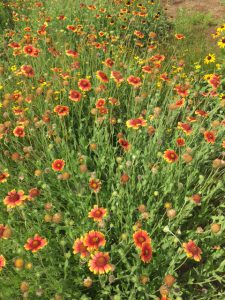 National Pollinator Week is only recognized in June, but efforts to encourage pollinators shouldn’t end then.
National Pollinator Week is only recognized in June, but efforts to encourage pollinators shouldn’t end then.
Pollination occurs when pollen grains are moved between two flowers of the same species, or within a single flower, by wind or animals that are pollinators. Successful pollination, which may require visits by multiple pollinators to a single flower, results in healthy fruit and fertile seeds, allowing plants to reproduce. Without pollinators, we simply wouldn’t have many crops!
Worldwide, approximately 1,000 plants grown for food, beverages, fibers, spices, and medicines need to be pollinated by animals in order to produce the goods on which we depend. Foods and beverages produced with the help of pollinators include blueberries, chocolate, coffee, melons, peaches, pumpkins, vanilla, and almonds.
About 75% of all flowering plants rely on animal pollinators and over 200,000 species of animals act as pollinators. Of those, about 1,000 are hummingbirds, bats, and small mammals. The rest are insects such as beetles, bees, ants, wasps, butterflies, and moths. Western honey bees are the most common.
Most species of bees don’t sting. Although all female bees are physically capable of stinging, most bee species native to the U.S. are “solitary bees,” that is, not living in colonies and don’t sting unless they are physically threatened or injured. Only honey bees are defensive and may chase someone who disturbs their hive.
It is wise, though, to avoid disturbing any bee or insect nest.
What everyone can do for pollinators:
Watch for pollinators. Get connected with nature. Take a walk, experience the landscape and look for pollinators which are most active midday in sunny, planted areas.
Reduce your impact. Reduce or eliminate your pesticide use, increase green spaces, and minimize impervious surfaces.
Plant for pollinators. Create pollinator-friendly habitat with native flowering plants that supply pollinators with nectar, pollen, and homes. For a list of plant choices go to: http://gardeningsolutions.ifas.ufl.edu/design/gardening-with-wildlife/bee-plants.html
What you can do to create a pollinator-friendly habitat:
Design your garden so that there is a continuous succession of plants flowering from spring through fall. Check for the species or cultivars best suited to your area.
Plant native to your region using plants that provide nectar for adults plus food for insect larvae, such as milkweed for monarchs. If you do use non-native plants, choose ones that don’t spread easily, since these could become invasive.
Select old-fashioned varieties of flowers whenever possible because breeding has caused some modern blooms to lose their fragrance and/or the nectar/pollen needed to attract and feed pollinators.
Install ‘houses’ for bats and native bees. For examples go to: http://edis.ifas.ufl.edu/uw290 or http://gardeningsolutions.ifas.ufl.edu/design/gardening-with-wildlife/pollinator-hotels.html
Avoid pesticides, even so-called “natural” ones such as Bacillus thuringiensis (Bt). If you must use them, use the most selective and least toxic ones and apply them at night when most pollinators aren’t active.
Supply water for all wildlife. A dripping faucet or a suspended container with a pinhole in the bottom is sufficient for some insects. Other wildlife need a small dish of water.
Provide water for butterflies without letting it become a mosquito breeding area. Refill containers daily or bury a shallow plant saucer to its rim in a sunny area, fill it with coarse pine bark, sand or stones and fill to overflowing with water.
Fun facts:
A tiny fly (a “midge”) no bigger than a pinhead is responsible for the world’s supply of chocolate
One out of every three mouthfuls of food we eat is delivered to us by pollinators.
- What is Titi? - March 22, 2024
- Taking Care of the Plants Inside - February 8, 2024
- Celebrate Trees in January - January 4, 2024
